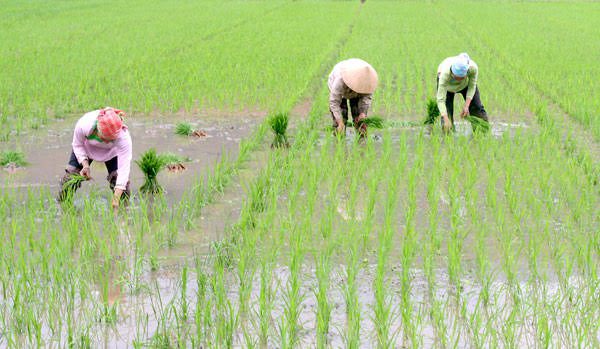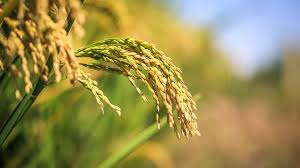The Growing Guide and Economic Importance of Planting Rice
Planting rice is an essential activity for many people around the world. People plant rice to grow it for food, and it involves several steps. First, farmers choose a field where they will plant the rice. They prepare the field by plowing the soil. This helps to loosen the soil and make it easier for the rice seeds to grow. After plowing, the field is often flooded with water. This is because rice plants like to grow in water.
Once the field is ready, farmers sow the rice seeds. They scatter the seeds across the field, making sure they are evenly spread. After sowing the seeds, the farmers wait for the rice plants to grow. This requires patience because it takes time.
As the rice plants grow, they need nutrients to become strong and healthy. Farmers may use fertilizers to provide these nutrients to the plants. Additionally, they need to ensure that the field stays flooded with water. This is important for the rice plants to thrive.
When the rice plants are fully grown, they produce rice grains. Harvesting the rice is the next step. Farmers carefully cut the rice plants and gather them to collect the grains. This is hard work, but it is necessary to obtain the rice that will be used as food.
After harvesting, the rice grains need to be separated from the rest of the plant. This process is called threshing. Once the grains are separated, they can be used for cooking or stored for later use.
In some places, people still plant rice using traditional methods, while in others, modern machinery is used to make the process more efficient. Regardless of the method, planting rice is a vital part of agriculture and plays a crucial role in feeding communities worldwide.
Moreover, planting rice is not just about growing a crop; it involves a deep connection with nature and the changing seasons. Farmers keenly observe the weather, as it greatly influences the growth of rice. Too much rain or drought can affect the yield, making it important for farmers to adapt to these natural variations.
Rice cultivation is often a communal effort, with families and neighbors coming together during planting and harvesting seasons. This fosters a sense of unity and shared responsibility within communities. The knowledge of planting rice is often passed down through generations, creating a tradition that connects people to their cultural roots.
In addition to being a staple food, rice paddies contribute to the landscape’s beauty. The sight of lush green fields, reflecting the sky in the water, is a serene and picturesque scene. Many regions that cultivate rice have breathtaking landscapes shaped by the rhythmic cycles of planting and harvesting.
The cultivation of rice has evolved over time, with advancements in agricultural practices and technology. Some farmers now use machines to plow and harvest, making the process more efficient. However, in many places, traditional methods persist, emphasizing the importance of a sustainable and harmonious relationship between humans and the environment.
Planting rice is not just an agricultural activity; it represents a way of life for those who depend on it. It teaches patience, hard work, and an understanding of the delicate balance between humans and nature. As we appreciate a bowl of rice on our tables, it’s worth recognizing the intricate journey it takes from the flooded fields to our plates, embodying the essence of sustenance and cultural heritage.
Read Also: Guide to Proper Management of Piglets
Guide to Planting Rice

To plant rice successfully, follow these steps:
1. Selecting a Field: Choose a flat and well-drained field for planting rice. It’s essential to have easy access to water for flooding the field later.
2. Soil Preparation: Plow the soil to loosen it, making it easier for the rice roots to grow. Ensure the field is free of debris and rocks. Properly leveled soil helps with uniform water distribution.
3. Flooding the Field: Flood the field with water to create a muddy environment. Rice plants thrive in waterlogged conditions. Maintain the water level throughout the growing season.
4. Seed Selection: Choose high-quality rice seeds. Ensure they are disease-free and suitable for the local climate. Better seeds contribute to a healthier crop.
5. Sowing the Seeds: Scatter the seeds evenly across the flooded field. Broadcasting the seeds ensures a uniform distribution, promoting consistent growth.
6. Germination and Early Growth: Wait for the seeds to germinate. During this stage, it’s crucial to monitor water levels. Too much or too little water can affect germination and early growth.
7. Fertilization: Provide the rice plants with nutrients by applying fertilizers. This supports healthy growth and enhances the yield. Follow recommended guidelines for fertilizer application.
8. Weed Control: Regularly check for weeds and remove them. Weeds compete with rice plants for nutrients and can hinder their growth.
9. Pest and Disease Management: Monitor the field for pests and diseases. Use appropriate pesticides if necessary, but be mindful of their impact on the environment.
10. Maturation and Harvesting: Allow the rice plants to mature. The grains are ready for harvest when they change color and become firm. Harvest by cutting the plants close to the ground.
11. Threshing: Separate the rice grains from the harvested plants. Traditional methods involve beating the harvested plants to release the grains, while modern machinery can be used for efficiency.
12. Drying and Storage: Dry the harvested rice grains thoroughly before storage. Proper drying prevents mold growth. Store the rice in a cool, dry place to maintain its quality.
By following these steps, you can contribute to a successful rice harvest, ensuring a vital source of food for communities and fostering sustainable agricultural practices.
Economic Importance of Planting Rice
The economic importance of planting rice is profound, impacting both local and global economies in several ways:
1. Food Security: Rice is a staple food for a significant portion of the world’s population. Planting rice ensures a stable and reliable food source, contributing to global food security. It plays a crucial role in alleviating hunger and malnutrition in many regions.
2. Employment Opportunities: Rice cultivation provides employment opportunities for millions of people worldwide. From planting and harvesting to processing and distribution, the entire rice production chain creates jobs in rural and urban areas, supporting livelihoods and local economies.
3. Income Generation: For many farmers, rice cultivation is a primary source of income. Selling rice grains in local markets or to larger distributors enables farmers to support their families, invest in their farms, and contribute to the overall economic development of their communities.
4. Trade and Commerce: Rice is a major commodity in international trade. Countries that excel in rice production often engage in exporting surplus rice to other nations. This fosters economic ties between countries and contributes to the global economy.
5. Agro-Industries and Processing: Rice cultivation leads to the development of agro-industries involved in processing and packaging rice products. This includes rice mills, packaging units, and other related businesses. These industries contribute significantly to the economy and create additional job opportunities.
6. Infrastructure Development: The economic importance of rice extends beyond the fields. The demand for rice stimulates investments in rural infrastructure, including irrigation systems, roads, and storage facilities. This, in turn, enhances overall agricultural productivity and connectivity.
7. Social and Cultural Impact: Rice cultivation often plays a central role in the social and cultural fabric of communities. Festivals and traditions related to planting and harvesting rice contribute to the tourism industry, generating revenue and supporting local economies.
8. Diversification of Income Sources: Rice farming can support diversified income sources for farmers. For example, by-products of rice cultivation, such as rice straw, can be used for livestock feed or in the production of bioenergy, adding value to the overall agricultural system.
9. Foreign Exchange Earnings: Countries that export rice contribute to their foreign exchange earnings. Revenue generated from rice exports can be used to import other goods and services, strengthening the economic position of the exporting nation.
Additionally, planting rice is not only essential for feeding a large portion of the world’s population but also plays a pivotal role in economic development, job creation, and the overall well-being of communities on a global scale.
Read Also: Pigs Breeding Cycle and Recommended Practices
Uses of Rice

Rice, a versatile grain, has numerous uses across various aspects of human life:
1. Food Staple: The primary and most widespread use of rice is as a staple food for a large portion of the global population. It serves as a main dish or side dish and is consumed in various forms such as white rice, brown rice, and specialty varieties.
2. Nutritional Value: Rice is a rich source of carbohydrates and provides essential nutrients such as vitamins and minerals. Brown rice, in particular, retains more nutrients due to its bran layers.
3. Culinary Applications: Rice is a versatile ingredient in cooking. It can be steamed, boiled, fried, or ground into flour for various culinary preparations, including rice cakes, noodles, and rice-based desserts.
4. Beverage Production: Rice is used in the production of rice milk and rice wine, adding diversity to beverage options for those with dietary restrictions or cultural preferences.
5. Industrial Uses: Rice bran, a by-product of rice milling, is used in various industrial applications. It can be processed into oil, used in cosmetics, and employed in the manufacturing of soaps and other products.
6. Livestock Feed: Rice straw and broken rice grains are used as feed for livestock, providing an additional income source for farmers and contributing to the livestock industry.
7. Biodegradable Products: Rice husks, another by-product of milling, are used to create biodegradable products such as packaging materials and tableware. This supports environmentally friendly practices.
8. Traditional Medicine: In some cultures, rice water is used for its potential health benefits. It is believed to have soothing properties and is sometimes used in traditional medicine for skin care.
9. Cultural and Ritual Use: Rice holds cultural significance in many societies and is often used in rituals, ceremonies, and festivals. It symbolizes fertility, prosperity, and abundance in various cultures.
10. Economic Trade: Rice is a major commodity in international trade. Countries that produce surplus rice often export it, contributing to global trade and economic exchange.
11. Textile Industry: Rice starch is used in the textile industry for sizing and finishing fabrics. It provides stiffness to the fabric and improves its appearance.
12. Biotechnology and Research: Rice is a key model organism in scientific research, especially in genetics and biotechnology. The rice genome has been extensively studied, contributing valuable insights to plant biology.
In essence, the uses of rice extend far beyond the dinner table, touching upon various aspects of agriculture, industry, culture, and research. Its versatility and significance make it a crucial element in human societies worldwide.
Read Also: Food Preservation Methods









